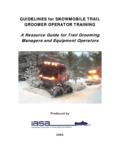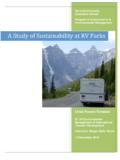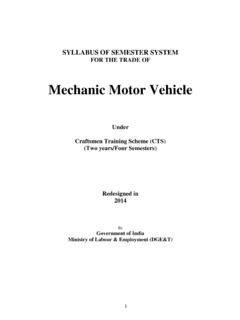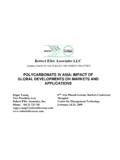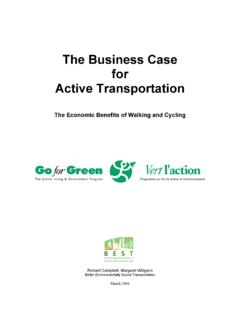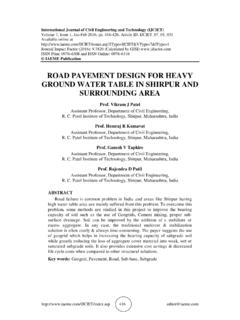Transcription of Facts and Myths About Snowmobiling and Winter Trails
1 Facts and Myths About Snowmobiling and Winter TrailsPhoto by Kim RaapAcknowledgementsthis publication was developed by the American council of snowmobile Associations (AcsA) with funding provided by the Recreational Trails Program administered by the department of transportation Federal Highway Administration (FHwA). It updates a similar booklet originally published by AcsA in 2009. the AcsA provides national leadership and coordination to advance the efforts of all organizations who promote responsible Snowmobiling across the United states. Visit for additional information About Snowmobiling safety and access. writing and photography were provided by kim Raap/ Trails work consulting; design, layout and printing were provided by Printing; and the cover photos along with numerous other photos were provided by the International snowmobile manufacturers Association (IsmA).
2 This document is disseminated under the sponsorship of the department of transportation in the interest of information exchange. the government assumes no liability for the use of information contained in this government does not endorse products or manufacturers. trademarks or manufacturers names appear in this publication only because they are considered essential to the objective of this product. The contents of this publication reflect the views of the authors, who are responsible for the Facts and accuracy of the data presented herein. The contents do not necessarily reflect the official policy of the Department of Transportation. This publication does not constitute a standard, specification, or regulation. the purpose of this publication is educational only, with no other intent but to expand readers knowledge About Snowmobiling management.
3 It should not be assumed by the reader that all contributors agree with every written word. the authors, contributors, FHwA, Trails work consulting, AcsA, IsmA and their members accept no liability resulting from the compliance or noncompliance with the procedures or recommendations given herein, or for the accuracy or completeness of the information contained 2014 American council of snowmobile Associations Printed on Recycled Paper10% Post-consumer recycled fiber, ECF papermaking, FSC CertificationsFI - good for you, good for our forests A PRoVIdeR oF mUltIPle Use Trails And oPPoRtUnItIes ..4 There are over 135,000 miles of snowmobile Trails in the United States and the majority of them are open to other recreation uses like cross-country skiing, dog sledding, snowshoeing or Winter hiking and bicycling.
4 These Trails are funded solely by snowmobilers and shared openly with other cAtAlyst FoR Winter economIes ..6 Snowmobiling generates over $26 billion in annual spending across the United States. Much of this occurs in rural areas, which helps keep businesses open year-round while also providing jobs and generating tax revenues for governments. cooPeRAtIVe PARtneRsHIPs ..8 Snowmobilers continually reach out to work with land managers. Their funding and volunteer labor provides trail grooming and clearing, signing, trailhead and trailside facilities, law enforcement, trail monitoring, safety and ethics education, avalanche forecasting, and search and rescue equipment - which ultimately benefits many other And VegetAtIon comPActIon ..10 Numerous scientific studies have concluded there are no detrimental effects to soil or vegetation from Snowmobiling .
5 Given adequate snowfall and responsible operation, all evidence of snowmobile operation generally disappears when the seasons change and snow And AIR QUAlIty ..12 Snowmobile engines are dramatically cleaner than they are portrayed and have changed immensely. National Ambient Air Quality Standards have never been exceeded anywhere due to snowmobile And wAteR QUAlIty ..14 Extensive scientific studies have looked at water chemistry from snowmelt runoff in busy Snowmobiling areas and concluded that levels were well below EPA criteria and well below levels that would adversely impact aquatic leVels ..16 Snowmobile sound levels have been reduced 94% as compared to early models. Snowmobile manufacturers employ state of the art noise reduction technologies and have significantly modified their exhaust system designs over the past several ImPActs.
6 18 Numerous studies have concluded that snowmobile activity has no significant effect on wildlife populations. After years of intensive snowmobile/wildlife monitoring in Yellowstone National Park, researchers concluded that the debate regarding the effects of motorized recreation on wildlife is largely a social issue as opposed to a wildlife management issue. socIAl conFlIcts ..26 More emphasis needs to be placed on requiring varying user groups to play together in the sandbox versus succumbing to pressures to segregate uses. Education should be focused on how to better share the powder rather than enacting more area FoR mUltIPle Use Winter Poor parking is the root stressor for Winter recreation conflicts and should be addressed first to best manage Winter recreation.
7 Snowmobilers require much larger trail networks and off-trail areas than nonmotorized users since they travel much farther on their day trips. twelVe PRIncIPles FoR mInImIzIng conFlIcts on mUltIPle Use Trails ..38 Light-handed approaches are essential to provide freedom of choice and desired environments. Overview of 4 Page 2 (ISMA photo) PrOvIder Of MuLtIPLe uSe Trails ANd OPPOrtuNItIeSISMA Photofriends to enjoy wintertime companionship while experiencing splendid scenery like no other season offers; opportunities for challenge, physical exertion and stress relief while recreating in the great outdoors; and opportunities to connect with nature in the solitude of secluded Winter backcountry. These opportunities combine to help teach respect and conservation of the environment, while also instilling a strong appreciation for private and public Trails are funded solely by snowmobile users through: Snowmobile registrations, Snowmobile trail or user permits, Snowmobile gasoline tax rebates, and An immense number of hours snowmobilers volunteer each year to clear, maintain, sign and groom efforts by snowmobilers often provide a myriad of opportunities for other Winter recreationists, including cross-country skiers, backcountry skiers, snowshoers, dog sledders, Winter hikers and bicyclists, and in some areas, Winter ATV riders.
8 All of this typically comes at no cost to the other Winter trail users. Additionally, many snowmobile Trails are also used by hikers, bicyclists, equestrian riders, OHV riders, and a host of other recreationists during the summer season. Contributions from snowmobilers help public land managers accomplish their goals for providing Winter recreation opportunities at little or no cost to the is a favorite Winter pastime for over two million people in the United States. Snowmobiling also helps provide a large number of recreation opportunities for other trail users since the majority of the 135,000 miles of snowmobile Trails in the are open for multiple uses and help provide important Winter access, services, and provides opportunities for families and Did you the majority of the 135,000 miles of snowmobile Trails are open for multiple HyBRId motoRIzed / nonmotoRIzed RecReAtIon Is gRowIng In PoPUlARIty.
9 Many backcountry skiers and snowboarders have embraced Snowmobiling as a means to gain access farther into the backcountry or closer to nonmotorized opportunities at Wilderness boundaries. These hybrid users value the ability snowmobiles give them to get 10 or 20 miles away from their vehicles which is substantially farther than they could ski into the backcountry on day trips. These cross-over motorized / nonmotorized recreationists represent the ultimate multiple use of public by Shad HamiltonPhotos by: (Clockwise from top left) Togwotee Winter Classic, Wyoming Stage Stop by Chris Havener, , ISMAPage 3 replace bottom right ( photo) Snowmobiling occurs on private and public lands across the northern tier of the country. It involves many different riding styles which include on-trail riding, cross-country riding off Trails in powder and gentle open areas, boon-docking in forested areas, and hill climbing in mountainous regions.
10 This wide range of riding styles requires an equally wide variety of recreation settings ranging from gentle on- and off-trail opportunities for families to challenging off-trail opportunities for experienced and expert growing trend is that particularly with the aging population more elderly and people with disabilities are using snowmobiles to access areas where they may have skied or snowshoed when they were more mobile. Snowmobiles also provide opportunities for disabled individuals and the elderly to experience the great outdoors in the Winter in a way that would not otherwise be technology has dramatically improved to the point where today s snowmobiles bear little resemblance to snowmobiles produced ten or twenty years ago. They are tightly regulated by the Environmental Protection Agency (EPA) and are consequently significantly cleaner and quieter than early models.
